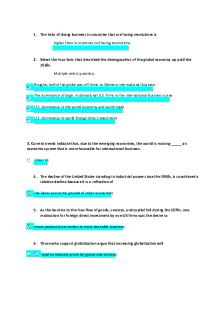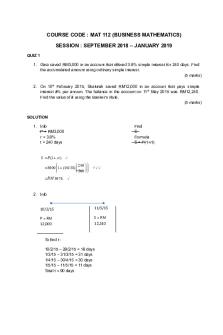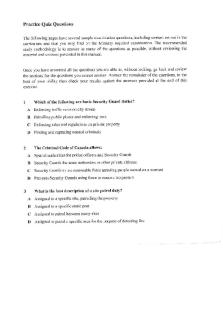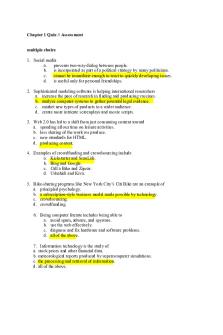Chapter 1 - quiz practice PDF

| Title | Chapter 1 - quiz practice |
|---|---|
| Course | Macroeconomics for Business |
| Institution | University of Southern California |
| Pages | 5 |
| File Size | 75.1 KB |
| File Type | |
| Total Downloads | 52 |
| Total Views | 184 |
Summary
quiz practice...
Description
Macroeconomics Test Yourself Chapter1
1.
A recession represents: a. an increase in the unemployment rate b. a reduction in stock prices c. two consecutive quarters of reduction in output d. a simultaneous reduction in economic activity and increase in inflation
2.
An a. b. c. d.
3.
Fluctuations refer to: a. alternating periods of expansions and recessions b. changes in stock prices c. movements in prices d. deviations of stock prices from their fundamental values
4.
Policy makers can become concerned if the unemployment rate is too low because: a. stock prices will fall b. inflation might increase c. output will decrease d. an exchange rate crisis might occur
5.
Which of the following might explain the relatively high unemployment rate in Europe? a. relatively high unemployment benefits b. relatively high minimum wage c. misguided macroeconomic policies d. all of the above e. both a and b
6.
Most economists believe that the fall in Japanese stock prices was caused by: a. monetary policy b. fiscal policy c. trade barriers d. the end of a speculative bubble
expansion represents: a reduction in the unemployment rate an increase in output an increase in stock prices a simultaneous increase in economic activity and reduction in inflation
7.
Which of the followings is considered capital in economics a. A $20 bill in your pocket b. A $1,000,000 saving of EZ corporation in the bank c. Stocks and bonds owned by individuals d. A calculator owned by a student e. All of the above
8.
Which of the following statements is (are) normative statement(s) a. A tax on tobacco industry will increase price of cigarettes and will reduce consumption of cigarettes. b. Government should increase taxes on tobacco industry to cut consumption of cigarettes by public. c. Smoking is bad for people. Government should raise sales taxes for cigarette. d. a and b e. b and c 9.
10.
11.
In economics, price paid to capital is called_________ a. dividend c. capital gain b. interest d. rent e. profit In economics, price paid to entrepreneur is called_______ a. dividend c. capital gain b. interest d. rent e. profit Recession is defined as ____________ a. a decline in the economy b. an increase in unemployment c. two consecutive quarters of decline in GDP d. decline in GDP and increase in Unemployment e. a mild depression
12.
Depression is defined as ______ a. a severe recession b. a long-lasting recession c. a double digit decline in GDP d. severe contraction in GDP resulting in a very high rate of unemployment e. all of the above 13. Other things the same, in the exports have __________ a- expansionary effect on the b- inflationary effect on the c- recessionary effect on the d- no effect on the economy
Circular Flow model of the economy, economy economy economy
14. Other things the same, in the Circular Flow model of the economy, trade deficit has ____________ a- expansionary effect on the economy b- inflationary effect on the economy c- recessionary effect on the economy d- no effect on the economy
15. Other things the same, in the government spending has _____ a- expansionary effect on the b- inflationary effect on the c- recessionary effect on the d- no effect on the economy
Circular Flow model of the economy, economy economy economy
16. Other things the same, in the Circular Flow model of the economy, budget surplus has _______ a- expansionary effect on the economy b- inflationary effect on the economy c- recessionary effect on the economy d- no effect on the economy 17. In the Circular will have _______ a- expansionary b- inflationary c- recessionary d- no effect on
Flow model of the economy, If exports > imports, trade effect on the economy effect on the economy effect on the economy the economy
18. In the Circular Flow model of the economy, If taxes < government spending, government budget will have _______________ a- expansionary effect on the economy b- inflationary effect on the economy c- recessionary effect on the economy d- no effect on the economy 19. If the nominal GDP is growing at a rate of 3% and inflation is 5% the real GDP is growing at a rate of ___________ a. 8% c. 15% b. 2% d. -2% e. -15% 20- GDP include earnings of ____________ a. U.S. citizen working abroad b. Aliens working in U.S.A c. U.S. citizen working in U.S.A d. a and c e. b and c 21. Other things the same, as US GDP increases trade deficit will _____________ a. increase b. decrease c. stay the same d. be ambiguous e. none of the above 22- The most volatile component of GDP is ________________ a. investment B. consumption c. government spending d. imports
23- The three main objectives of every economy are ____________ a. unemployment, inflation, growth b. economic welfare, high standard of living, wealth c. full employment, stable prices, economic growth d. Expansion, peak, growth 24-
Two groups most hurt by inflation are _______________ a. households and businesses b. borrowers and businesses c. lenders and people living on fixed income d. Labor and stock owners
25.
The two main conflicting objectives in macroeconomics are, a. stable prices and full employment. b. GDP growth and full employment. c. the price level and the inflation rate. d. GDP growth and stable prices. e. the unemployment rate and labor income.
26.
The two main complementary objectives in macroeconomics are, a. stable prices and full employment. b. GDP growth and full employment. c. the price level and the inflation rate. d. GDP growth and stable prices. e. the unemployment rate and labor income.
27. In the United States, labor income accounts for approximately what share of GDP? a. 68% c. 40% b. 50% d. 33% 28.
In the United States, capital income accounts for approximately what share of GDP? a. 65% c. 25% b. 50% d. 10%
29. For an open demand? a. C + I b. C + I c. C + I d. C + I 30. Which goods a. b. c. d. e.
economy, which of the following expressions represents + + + +
G + X G + X - M G + M - X G
of the following is an exogenous variable in our model of the market? consumption (C) saving (S) disposable income (YD) government spending (G) all of the above.
Key 1. 2. 3. 4. 5. 6. 7. 8. 9. 10. 11. 12. 13. 14. 15. 16. 17. 18. 19. 20. 21. 22. 23. 24. 25. 26. 27. 28. 29. 30.
c b a b e d d e b e c b a c a c a a d e a a c c a b a c b d...
Similar Free PDFs

Chapter 1 - quiz practice
- 5 Pages

MGT2381 Chapter 1 Practice Quiz
- 6 Pages

Chapter 24 quiz - Practice Quiz
- 3 Pages

Chapter 7 Practice Quiz
- 19 Pages

Practice Quiz Chapter 3
- 6 Pages

Chapter 3 - quiz practice
- 5 Pages

Chapter 48 Practice Quiz
- 3 Pages

Sample Quiz #1 - Practice Quiz
- 2 Pages

Patho Practice Quiz 1
- 5 Pages

HW 1 - Quiz Practice
- 7 Pages

Practice Quiz 1
- 2 Pages

QUIZ 1 MAT112 Practice
- 2 Pages

Practice Quiz 1 - Exam
- 24 Pages

Practice Quiz 1
- 11 Pages
Popular Institutions
- Tinajero National High School - Annex
- Politeknik Caltex Riau
- Yokohama City University
- SGT University
- University of Al-Qadisiyah
- Divine Word College of Vigan
- Techniek College Rotterdam
- Universidade de Santiago
- Universiti Teknologi MARA Cawangan Johor Kampus Pasir Gudang
- Poltekkes Kemenkes Yogyakarta
- Baguio City National High School
- Colegio san marcos
- preparatoria uno
- Centro de Bachillerato Tecnológico Industrial y de Servicios No. 107
- Dalian Maritime University
- Quang Trung Secondary School
- Colegio Tecnológico en Informática
- Corporación Regional de Educación Superior
- Grupo CEDVA
- Dar Al Uloom University
- Centro de Estudios Preuniversitarios de la Universidad Nacional de Ingeniería
- 上智大学
- Aakash International School, Nuna Majara
- San Felipe Neri Catholic School
- Kang Chiao International School - New Taipei City
- Misamis Occidental National High School
- Institución Educativa Escuela Normal Juan Ladrilleros
- Kolehiyo ng Pantukan
- Batanes State College
- Instituto Continental
- Sekolah Menengah Kejuruan Kesehatan Kaltara (Tarakan)
- Colegio de La Inmaculada Concepcion - Cebu

